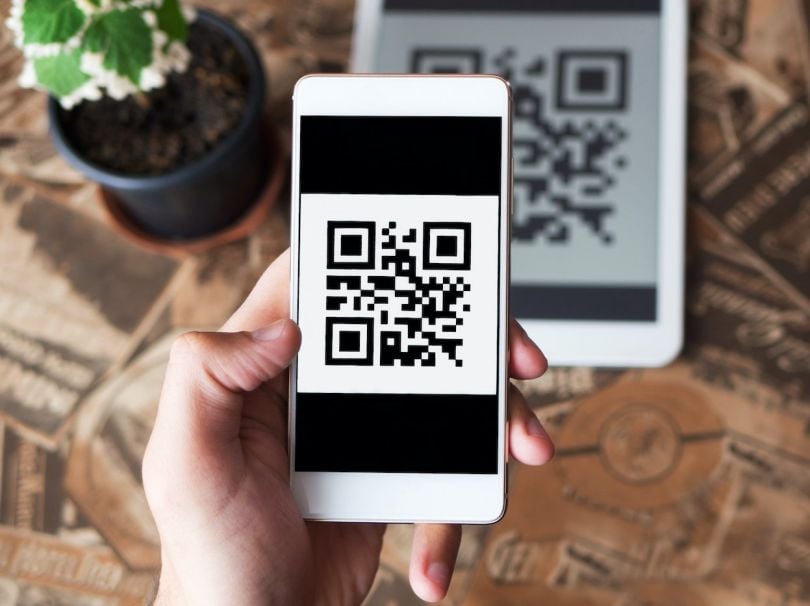
The COVID-19 pandemic has completely changed the way we interact with each other. We don’t shake hands, or hug. We are expected to stay six feet apart from each other whenever we can.
This new contactless reality has extended into the way we interact with businesses too. For instance, if you’ve sat down at a restaurant in the last 10 months, you’ve probably used a QR code — those little scannable black-and-white patterns — to pull up the menu on your smartphone. Meanwhile, PayPal and Venmo launched their own QR code payment features over the summer, which CVS says it plans to put in more than 8,000 of its locations.
One of the companies behind these QR codes is MobStac, an NYC startup that specializes in what it calls “proximity marketing” technology. This includes bluetooth beacons, geofencing and near-field communication, as well as QR codes. In a nutshell, co-founder and CTO Ravi Pratap Maddimsetty thinks of the products MobStac sells as a means of “connecting the physical and digital worlds.”
“This phone that we all have in our pockets, the smartphone, everyone carries one and it’s always connected to the online world. Why doesn’t it do a better job of connecting with the physical world around us, too?” Maddimsetty told Built In. “That’s really what we do. We help brands, retailers, consumer goods companies, restaurants — all these different kinds of businesses — connect the physical and digital worlds.”
Of course, QR codes (short for “quick response” codes) aren’t necessarily new technology. In fact, they’ve been around in some form or another since 1994, with very little mainstream success. According to Maddimsetty, their use really took off around 2017 when they became scannable through iPhone and Android cameras, removing the need for additional apps. For years, they remained just a cool, tech capability some companies offered.
Then the COVID-19 pandemic hit, prompting various Centers for Disease Control and Prevention guidelines restricting hospitality industry mainstays like reusable menus for restaurants. These businesses needed to come up with contactless alternatives, and quickly turned to QR codes.
This, Maddimsetty says, prompted a rapid surge in demand for the company’s technology. Today, nearly 3,000 businesses around the world use MobStac, and the platform is averaging around three million QR scans each month — a growth of 55x over the course of 2020.
The company’s new customers aren’t just restaurants either. Maddimsetty says some of MobStac’s biggest customers are consumer goods brands like Nestlé and Revlon, which put QR codes on their packaging to communicate directly with their audience in interesting ways.
“That’s a trend in itself. These companies want to communicate directly with customers, right from the retail shelf, which is something they haven’t been able to do so far,” Maddimsetty said. “QR codes right on the packaging allows them to tell the whole story. And that story is beyond just, ‘OK, go to the website.’ It’s actually through videos, through landing pages. In some cases, they’re user manuals where people can learn more about how to use the product, and so on. It’s all of these visions that have really picked up during the pandemic.”
Looking beyond the pandemic, Maddimsetty thinks contactless tech like QR codes are only going to grow in popularity. He says demand for MobStac’s products hasn’t just been growing in COVID hotspots like the United States. The use of QR codes in Australia, one of the few countries that has almost eliminated the coronavirus, has grown “tremendously,” indicating this kind of technology is here to stay.
Maddimsetty says the key reason for this has to do with efficiency: QR codes are a much more efficient, eco-friendly way to communicate with consumers.
“If you’re a consumer goods company, you can speak directly with your customers through your own products. Your products are doing the talking for you,” Maddimsetty said. “We think it’s going to become the standard. Just like when you pick up a product these days and it has the barcode on it. I think QR codes will be on every physical [product].”
In fact, Maddimsetty says we are just seeing the tip of the iceberg of what contactless technology is capable of. And he expects MobStac is going to not only ride that wave, but lead the charge in this shift.
“If you look at the size of overall commerce — not just retail, physical goods, all physical spaces around the world — that is a massive, massive opportunity. It’s all yet to come online, it’s all yet to really go digital,” Maddimsetty said. “I’m excited that we are getting to play in this space.”
In the meantime, the company plans to double its headcount of 30 employees over the next year, hiring across various departments at its NYC headquarters and its office in Bangalore, India.




